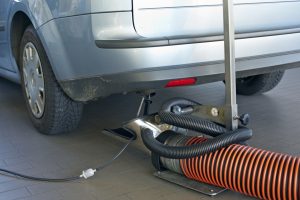
The reduction of pollutants in emissions
Combustion engines of all kinds produce emissions. Some of these emissions are pollutants which endanger our environment, human health as well as flora and fauna. The particularities of the burning of fuel in an engine, determine the amount and characteristics of the emissions. The burning process should reach a smooth and complete combustion of the fuel within the maximum possible volume of the combustion chamber. Thus the burning process should eliminate a local temperature and pressure increase and ensure a smooth process with the sufficient supply of oxygen in a way that no different temperature zones will occur in the combustion chamber.
In modern engines, this process is controlled by:
- The fuel injection (start and length of the injection)
- The exact time of the ignition
- Quality and composition of the fuel-air mixture
- Time intervals of the exhaust valves
- Ambient air-temperature
- etc.
The above factors determine the amount and which pollutants (CO, HC, NOx and SOx) will appear in the emissions. Tests under real conditions have shown that without additional treatment of the emissions by e.g. catalysts and other measures, only the Euro-Norm 2 can be reached.
Improve the viscosity and clean the oil rings
An additional question is that if engine-oil reaches the combustion chamber to what extend this oil influences the combustion process. Specialists estimate that oil in the combustion chamber will increase the amount of HC and CO in the emissions. The use of our technology in engine-oil will reduce the actual oil consumption significantly. This happens via the shattering and removal of the carbon remains on the piston-rings, as through a local increase of the viscosity in the surroundings of the piston-rings.
Two-stage fuel combustion process reduces the swirly (explosive) course of fuel combustion.
The liquid technology oil-mixture reaches the combustion chamber as aerosol and stays there during the whole combustion process, which means during the compression phase, the actual fuel injection phase and during the ignition phase. The time-delay between the fuel injection and the ignition is around 10 ⁻³ Sec. In engine-oil our products form a macro-molecular structure. This structure interacts with the already existing substances in the combustion chamber, this interaction takes only 10 ⁻⁵ Sec. – 10 ⁻⁷ Sec.
In addiıon the tıme-delay between compression and ignition is sufficient to dispense the liquid technology oil-mixture with the fuel-air mixture equally in all areas of the combustion chamber. Furthermore the mixture will free the cylinder walls and injection nozzles from unwanted deposits and the solid elements of our liquid technology will modify the surfaces of the combustion chamber. Numerous “micro spark-plugs” are build-up which leads to a complete and total burning of the fuel and accelerates the burning process. Two different fuel structures are build-up in the combustion chamber. One with our liquid technology and one with the normal air/fuel mixture. These mixtures burn at different speeds. A “two-stage” fuel burning, timely delayed process is activated which reduces the explosive nature of the fuel burning process in combustion chambers.
Full combustion and effective use of fuel
By the use of our products the course of the burning process is moved in a direction which allows a “complete” and “steady” combustion. The heat energy is being spread evenly, whereby local temperature and pressure bursts are reduced. The pressure in the cylinder increases faster, whereby the highest pressure-point is flattened. Due to this flattening of the curve, a more effective combustion process will be reached which consequentially leads to a better engine performance, a better fuel efficiency and a reduction of the engine’s emissions (NOx, HC and CO). The presence of engine-oil in the combustion chamber, which is assumed as questionable, will move into a direction where it gets close to the ideal combustion process by the use of our liquid technology. It ensures a more effective use of the fuel energy and reduces the engine’s emissions.
This procedure shows an effective and lasting way of the exhaust gas optimation and the pollutant load in the environment. Everything what you must do, is to treat the engine of your vehicle with our combined product. They make such a constribution to a clean environment and the reduction of smog.
Note: our method of the exhaust gas optimisation of vehicles with internal combustion engine is a very favorable, nevertheless effective way. With pleasure we also support public institutions in view of a vehicle park solution or political institutions in order to receive a local solution of environmental problems.
By the way: the use of our liquid technology has also achieved best results in the „Indoorkarttrack“ and has reduced the pollutant load for visitors and sportsmen clearly.



